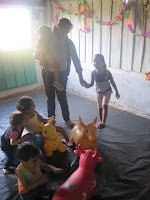In my post from exactly one week ago I promised to write more about CENFIC and so here we are:
 |
| Jose with his father Juan. |
In 1976 Juan de Dios Salinas was disappeared by the Stroessner dictatorship. He was killed for his role in the Christian Agrarian League which worked for the advancement of Paraguay's campesinos.
In 1998 he reappeared. That was the year that his son, Jose Babadilla, began
CENFIC Juan De Dios Salinas (Centro Nacional de Formacion Integral Campesina) on 5 hectares of donated land in a place called O'Leary.
Jose explains to us that Campesino leaders from our partner
MCP recognized the lack of educational opportunity for campesino youth and realized they had to form the next generation of the movement. How else could they pass on the values of life on the land? The countryside is bleeding campesino's into the city as large transnational industrial farms gobble up more and more land.
CENFIC is a school designed to help stop the bleeding.
CENFIC is not only educating young people in the practice of campesino
cultivation, but also the importance of campesino
culture. Without culture there can be no cultivation.
 |
| Centro Nacional de Formacion Integral Campesina, Juan de Dios Salinas |
Due to a complete lack of government support at the start, the school only opened its doors 2006 with 25 students. Today there are 86 and all but 15 board here. The students must be at least 13 to attend and they complete grades 7-9 here. If a student didn't complete earlier schooling, they may be as old as 20 by the time they are done (as opposed to 15). 12 different teachers who rotate through are responsible for their education. I ask one of them, Victor, what the salary is like. It's less than $400 a month. They don't do this for the money but for the people and the culture.
 |
| Victor Fretes, Teacher and coordinator of Agriculture at CENFIC shows us the school nursery |
In addition to the national curriculum, which includes instruction in the Guarani language, students at
CENFIC learn how to compare the pros and cons of industrial agriculture vs. organic sustainable argiculture and are educated in the latter
. The school is free. Parents, having little or no money to spend on education, will still sometimes contribute food. A large part of what is eaten here is grown here. Some is sold to help keep the school going. We see large gardens on what has now become a larger operation - in addition to the diverse crops there is mandioca, sugar cane, and maize.
Students not only learn how to grow crops and raise animals, but also how to care and cultivate the natural Atlantic forest, most of which has disappeared in the rush to industrial agriculture. We take a walk through the forest on the land and see where students learn to plant new trees.
 |
| Planting Trees... |
They have really just the most basic tools, no expensive irrigation systems and the well is hand-dug (they are working on gov't funding for a proper one). I am awed by how a small number of people are able to produce the food here that they do. The students work very hard.
 |
| All the watering done by hand. |
"Looking after the Earth", "Keeping a Kitchen Garden", "Natural Insecticides and pest reduction" these are all things that are taught not just to students but even to adult members of the
MCP as well, who partake in special trainings for adults here.
 |
| The Chickens of CENFIC :) |
We share a wonderful meal with the teachers and students and drink freshly squeezed sugar cane juice while talking with Jose about how vital the education of young campesino's is for not just the country of Paraguay, but indeed the whole planet. All of humanity will benefit from the farming practices of the campesinos that serve to reduce carbon emissions and combat climate change.
We finish our meal and walk towards the van to say goodbyes. Something colourful catches my eye. Freshly cleaned laundry blows lightly in the wind that sends it breath running through the whole place. Yes, Juan de Dios Salinas has reappeared.









































